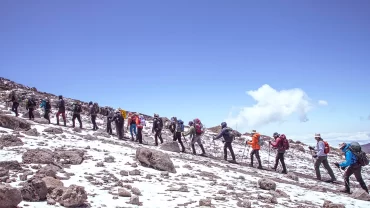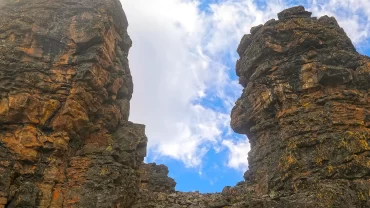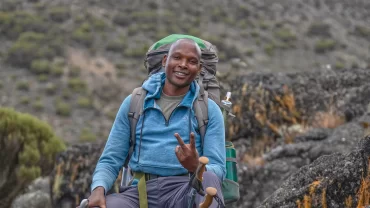The Less-Traveled High-Altitude Kilimanjaro Trek
1. Introduction to the Shira Route
The Shira Route is one of the lesser-known and less frequently used routes on Mount Kilimanjaro (5,895m / 19,341 ft). It is an older alternative to the Lemosho Route, following a similar path but with a major difference in the starting altitude. Trekkers begin the climb at Shira Gate (3,600m / 11,811 ft), which bypasses the lush rainforest zone and heads straight to the Shira Plateau.
Due to this high starting altitude, the Shira Route is not recommended for first-time climbers, as it provides poor early acclimatization and increases the risk of altitude sickness.
2. Key Facts About the Shira Route
- Distance: ~56 km (35 miles)
- Duration: 7-8 days
- Difficulty Level: Moderate to Challenging
- Scenery: Moorland, alpine desert, glaciated summit
- Acclimatization Profile: Poor at the start, better later
- Success Rate: ~85% for 8-day trek, ~75% for 7-day trek
- Accommodation Type: Camping (no huts available)
- Best Time to Climb: January-March & June-October
3. Route Overview & Highlights
The Shira Route starts at Shira Gate, significantly higher than the traditional rainforest starting points on other routes. Trekkers skip the rainforest zone and begin hiking across the Shira Plateau before joining the Lemosho Route at Shira Camp.
Highlights of the Shira Route:
✅ Less crowded than Lemosho and Machame – fewer trekkers use this route.
✅ Panoramic views from the start – since the route begins at high altitude.
✅ Joins the Lemosho Route – sharing some of the most beautiful sections of Kilimanjaro.
✅ Good acclimatization later in the trek – though the first day is challenging.
4. Who Should Choose the Shira Route?
✅ Best for:
- Experienced climbers who have been at high altitudes before.
- Those who want a quiet and less crowded trail.
- Trekkers looking for a scenic route similar to Lemosho but with a different start.
❌ Avoid if:
- You are not well-acclimatized to high altitudes.
- You prefer starting at lower altitudes for a gradual climb.
- You want a high summit success rate (Lemosho is a better alternative).
5. Pros & Cons of the Shira Route
✅ Pros:
- Less crowded – offers solitude compared to busier routes.
- Beautiful scenery – similar to Lemosho, with great panoramic views.
- Gradual ascent after the first day – helping acclimatization in later stages.
❌ Cons:
- High starting altitude (3,600m / 11,811 ft) – increases altitude sickness risk.
- Lower success rate than Lemosho – due to the fast altitude gain.
- Bypasses the rainforest zone – missing a key part of Kilimanjaro’s ecosystem.
6. Acclimatization & Success Rate
The Shira Route has a poor acclimatization profile at the start, as it begins too high too quickly, skipping the gradual altitude gain that other routes provide.
- 8-day itinerary success rate: ~85%
- 7-day itinerary success rate: ~75%
- Why? Acclimatization improves later in the trek, but the first day can be tough for those sensitive to altitude.
7. Challenges & Difficulty Level
The Shira Route is moderately challenging, primarily due to its high-altitude start rather than its terrain.
Key Challenges:
- Rapid altitude gain on Day 1 – increases the risk of AMS (Acute Mountain Sickness).
- Misses the rainforest acclimatization phase – making it harder for beginners.
- Cold summit night – like all routes, temperatures at Uhuru Peak can drop below -10°C (14°F).
Preparation Tip: Spend a few days at high altitudes (3,000m / 9,800 ft or higher) before starting the climb to help acclimatization.
8. Best Time to Hike the Shira Route
Like other Kilimanjaro routes, the Shira Route is best climbed during the dry seasons:
- January to March: Quieter season, with stable weather conditions.
- June to October: Peak season with clear skies but more crowds.
Avoid: April-May & November (rainy seasons, making trails muddy and less enjoyable).
9. Packing & Preparation Tips
Packing for the Shira Route requires specific considerations due to its high-altitude start.
Essential Packing Items:
- Warm Clothing: Cold temperatures start from day one.
- Trekking Poles: Helpful for steep sections and rocky paths.
- Hydration System: CamelBak or water bottles to prevent dehydration.
- Sleeping Bag: Rated for -10°C (14°F) or colder.
- Altitude Medication: Consult a doctor about Diamox if prone to altitude sickness.
For a detailed packing guide, check out The Ultimate Tanzania Adventure Packing List.
10. Comparing the Shira Route with Other Kilimanjaro Routes
| Route | Difficulty | Duration | Success Rate | Accommodation | Crowds |
| Shira | Moderate-Challenging | 7-8 days | ~75-85% | Camping | Low |
| Lemosho | Moderate | 7-8 days | ~90% | Camping | Medium |
| Machame | Moderate-Challenging | 6-7 days | ~85% | Camping | High |
| Rongai | Moderate | 6-7 days | ~80% | Camping | Low |
| Marangu | Moderate | 5-6 days | ~50-60% | Huts | High |
If you want the best acclimatization, Lemosho or Northern Circuit are better choices. If you prefer a quieter route and are already acclimatized, Shira is a good option.
11. Final Thoughts: Is Shira the Right Route for You?
The Shira Route is ideal for experienced trekkers who have prior high-altitude experience and want a quieter, scenic trail. However, due to its high starting elevation, it is not recommended for beginners or those prone to altitude sickness.
Are you ready to explore Kilimanjaro via the Shira Route? Start planning your adventure today!
For more insights, check out How to Choose the Best Kilimanjaro Route.





Comment (0)